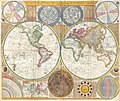Fil:1794 Samuel Dunn Wall Map of the World in Hemispheres - Geographicus - World2-dunn-1794.jpg

Størrelse på denne forhåndsvisningen: 712 × 600 piksler. Andre oppløsninger: 285 × 240 piksler | 570 × 480 piksler | 912 × 768 piksler | 1 216 × 1 024 piksler | 2 431 × 2 048 piksler | 6 000 × 5 054 piksler.
Opprinnelig fil (6 000 × 5 054 piksler, filstørrelse: 8,92 MB, MIME-type: image/jpeg)
Filhistorikk
Klikk på et tidspunkt for å vise filen slik den var på det tidspunktet.
| Dato/klokkeslett | Miniatyrbilde | Dimensjoner | Bruker | Kommentar | |
|---|---|---|---|---|---|
| nåværende | 1. jun. 2012 kl. 22:01 |  | 6 000 × 5 054 (8,92 MB) | Brandmeister~commonswiki | Reverted to version as of 04:17, 23 March 2011 |
| 19. mai 2012 kl. 18:15 |  | 6 000 × 5 054 (27,38 MB) | Brandmeister~commonswiki | contrast | |
| 23. mar. 2011 kl. 06:17 |  | 6 000 × 5 054 (8,92 MB) | BotMultichillT | {{subst:User:Multichill/Geographicus |link=http://www.geographicus.com/P/AntiqueMap/World2-dunn-1794 |product_name=1794 Samuel Dunn Wall Map of the World in Hemispheres |map_title=A General Map of the World, or Terraqueouis Globe with all the New Discover |
Filbruk
Den følgende siden bruker denne filen:
Global filbruk
Følgende andre wikier bruker denne filen:
- Bruk i alt.wikipedia.org
- Bruk i ar.wikipedia.org
- Bruk i av.wikipedia.org
- Bruk i br.wiktionary.org
- Bruk i ckb.wikipedia.org
- Bruk i cv.wikipedia.org
- Bruk i de.wikipedia.org
- Bruk i en.wikipedia.org
- Early world maps
- History of cartography
- Southern Ocean
- Samuel Dunn (mathematician)
- Wikipedia:Featured picture candidates/1794 Samuel Dunn Map
- A General Map of the World, or Terraqueous Globe
- Wikipedia:Featured picture candidates/June-2012
- User:Cruickshanks/sandbox2
- Wikipedia:Featured picture candidates/March-2014
- Wikipedia:Featured picture candidates/1794 Samuel Dunn Wall Map of the World in Hemispheres - Geographicus - World2-dunn-1794.jpg (review)
- User:Setvina/be bold
- Portal:Maps
- User:Sarangem
- User:Jacobwilder427
- Bruk i en.wiktionary.org
- Bruk i eo.wikipedia.org
- Bruk i et.wikipedia.org
- Bruk i eu.wikipedia.org
- Bruk i fa.wikipedia.org
- ویکیپدیا:نگارههای برگزیده/نقشه
- ویکیپدیا:گزیدن نگاره برگزیده/ژوئن-۲۰۱۲
- نقشه ساموئل دان
- ویکیپدیا:گزیدن نگاره برگزیده/1794 Samuel Dunn Wall Map of the World in Hemispheres - Geographicus - World2-dunn-1794.jpg
- ویکیپدیا:نگاره روز/اکتبر ۲۰۱۲
- الگو:نر/2012-10-03
- الگو:نر محافظت شده/2012-10-03
- بحث کاربر:Alborzagros/بایگانی ۷
- Bruk i fr.wikipedia.org
- Bruk i fr.wikiversity.org
- Bruk i gl.wikipedia.org
- Bruk i hu.wikipedia.org
- Bruk i hy.wikipedia.org
Vis mer global bruk av denne filen.
